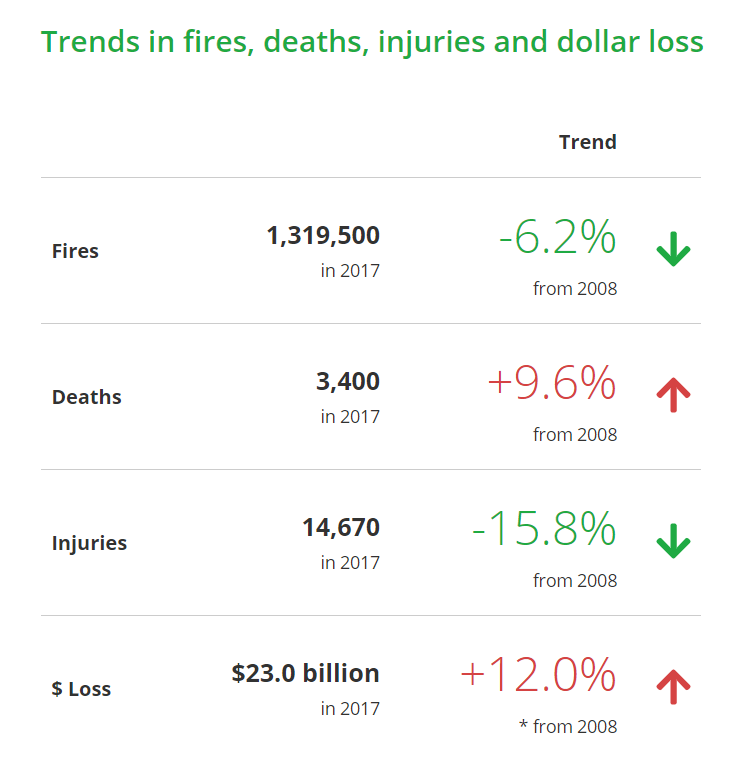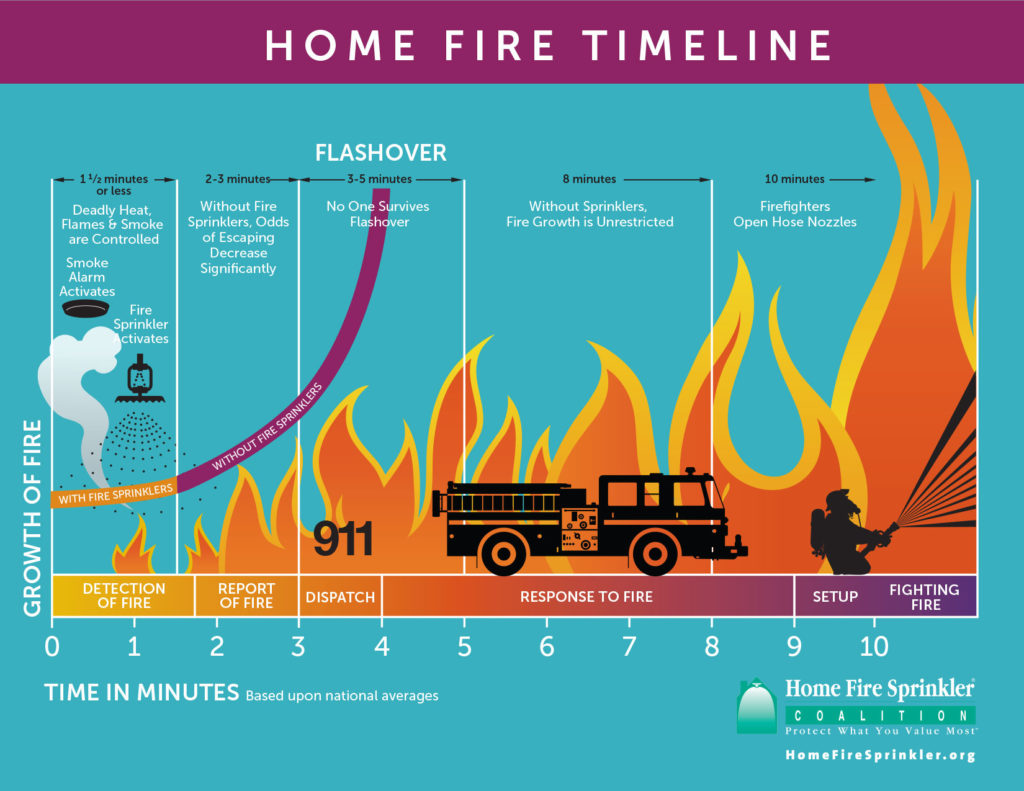By: Robert Avsec, Executive Fire Officer
Joel Sellinger is a firefighter with the Everett (Wash.) Fire Department and the co-founder of LifeDoor, Inc. Recently, Joel posted the following on LinkedIn:
Interesting data from the USFA (United States Fire Administration). The number of fires [in the U.S.] is down over 6 percent in 10 years, but fire related deaths [in the U.S.] are up over 10 percent in that same time. Any thoughts on why this is?

One of my talented fire service colleagues, Tanya Bettridge, who’s a fire and life safety educator and administrator with the Perth East (ON) Fire Department, replied to Joel with the following remarks (Tanya’s original remarks are in bold type and I’ve expounded on her thoughts with the regular font).
A few reasons that I can think of:
Newer homes and their contents burning quicker and with more toxins than before.
Building designers, architects, and builders who have revolutionized the construction industry with lightweight construction materials and construction designs that have reduced the mass of lumber used in construction. This new construction does its primary job—resisting gravity—very well but burns hotter and faster and is subject to degradation of its “gravity resistance” faster than housing built with full-dimension lumber before 1970. Fire behavior experts estimate the today’s home can reach flashover—the point at which the entire room or dwelling ignites in flames—800 percent faster than legacy homes built prior to 1970.
That same group has created floor plans with larger rooms with larger open spaces that facilitate the transfer of heat, smoke and toxic gases more quickly through the structure.
The designers and manufacturers of interior furnishings, e.g., cabinets, furniture, floor and wall coverings, etc., have replace wood and other natural fibers with synthetic materials and polymers many of which are petroleum-based.
This increased the fuel load in the typical residential structure substantially as well as increasing the number of known and unknown chemicals, chemical compounds, and known carcinogens that are released into the structure during combustion.
The bottom line? Once your working smoke alarm sounds (You do have working smoke alarms on all levels of your home, right?) you and your family likely have less than three minutes to safely escape your home following you Home Fire Escape Plan (You do have a Home Fire Escape Plan that you’ve practiced with your children, right?).
A steep incline of apathy toward anything fire or safety related (leads to lack of compliance). Historically, residents of the U.S. and Canada have had an attitude that “fires happen to other people.” And that’s simply not true. Almost all fires are preventable, especially those that occur in homes. Did you know that every year in the U.S. around 75 percent of fires are the result of improper human behavior? That’s right, adult people not attending to food cooking (the #1 cause for about 40 percent of fire every year regardless of the community) or using space heaters improperly or not properly disposing of fireplace or wood stove ashes.
Audiences are waiting for Deadpool 3 while our Pub Ed messaging is talking to them like they’re still watching Leave It to Beaver. Tanya’s done several articles on this very topic, one of which is Pub Ed Lessons from the US Election. The other, which is really “delicious” is What Fire Departments Can Learn from Beer Ads – PART I. That one is a two-parter and the second part is Emotional marketing can make for better fire safety messages.
They have no idea how little time fire needs to grow and how much time fire trucks will take to get there. So, you’ve probably got less than three minutes to get out of your home after the smoke alarm starts sounding. But the fire department still doesn’t know that you have a fire in your home until someone calls 911 to report the fire or if a passerby sees the fire and calls 911.
Figure 1 below shows this timeline in graphic detail. It may be three minutes or longer before the 911 call is received at your community’s dispatch center; then there’s another minute or more for the Emergency Telecommunicator to process the 911 call and dispatch the appropriate fire department.

Residents still think firefighters will rescue them if a fire happens. The timeline doesn’t lie. Even the best fire department is going to take 4-6 minutes to arrive at your burning home AFTER they’ve been dispatched (The 4-minute Mark in Figure 1).
If you or any member of your family is still in the home during the time it takes for the fire department to arrive, it’s highly likely that you will already have died from inhaling the toxic smoke that’s a mixture of those chemicals, chemical compounds, and carcinogens I mentioned earlier.
I’ll be perfectly blunt: Your best chance is if you live across the street from the fire station and that they firefighters are in the station and not on another call.
Career fire departments across the U.S. and Canada have lost staffing over the years and that means there are fewer firefighters on the fire trucks that arrive than ever before. Volunteer fire departments are hurting even more with declining membership rolls as older volunteers retire and are not replaced by newer volunteers.
Whether the fire department is career or volunteer or a combination, it takes at least three firefighters to enter a burning home and search for an occupant and remove them from the structure. Two firefighters to take a fire hose in with them to protect them and the occupant and one firefighter to operate the fire truck to ensure that they have adequate water and pressure in the hose. And that’s the bare minimum.
And it may be the total number of volunteer firefighters that arrive at the call. Period. Or it might be the number of career firefighters on a truck and it may be many more minutes before another truck arrives because closer trucks are on another emergency call.
The bottom line (Again!) is that YOU and YOUR family are responsible for your safety. It’s up to you to ensure that you have working smoke alarms in all the locations required for your type and size of home. It’s up to you to ensure that you’ve got a Home Fire Escape Plan and that you practice it with your family on a regular basis (And one or more of those practice sessions should be at night after your children are asleep).
Having a plan for keeping you and your family safe from a preventable fire must become one of the basics, just like providing shelter, clothing, and food.
Preventing fires deaths is not reflected in many fire department budgets. So, if the budget doesn’t take Pub Ed and Prevention seriously, why should the community? The typical fire department budget in the U.S. and Canada allocates less than one percent (1%) of its budget to all fire prevention activities: fire inspections, fire code enforcement, and fire and life safety public education.
Let’s look at some “easy” numbers: If a department had a total budget of $5.00, one percent of that budget would be $0.05. That’s right, a nickel. What’s the adage, “You get what you pay for?”
https://www.usfa.fema.gov/prevention/outreach/fief/
 Fire & EMS Leader Pro The job of old firefighters is to teach young firefighters how to become old firefighters!
Fire & EMS Leader Pro The job of old firefighters is to teach young firefighters how to become old firefighters!